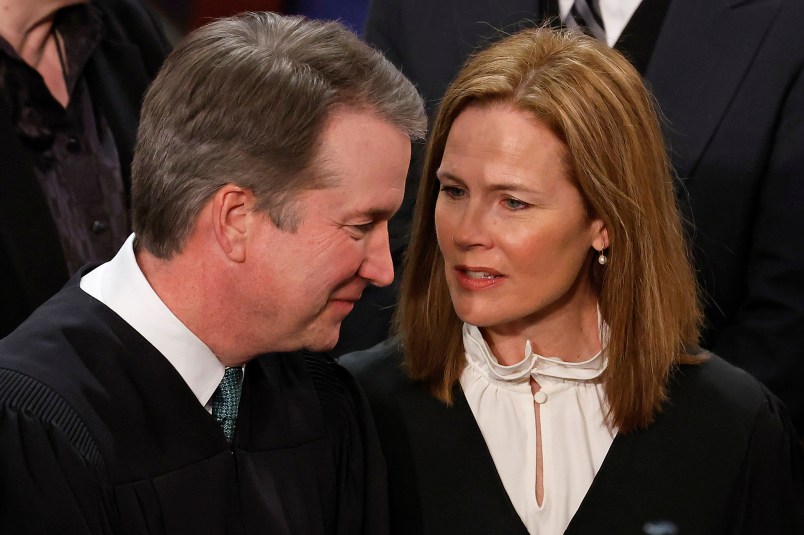In a striking echo of how they dispensed with abortion rights, many right-wing justices Wednesday advocated for a “leave it to the states” approach on trans health care, rhetorical cover for a legal logic that could open the door to nationwide bans and a potential blow to the Equal Protection Clause more broadly.
The case, U.S. v. Skrmetti, hinges on Tennessee’s ban on gender-affirming care for trans minors. It blocks those children from medical treatments — including hormones and puberty blockers — that it keeps available for minors seeking that treatment for other reasons.
The Biden Department of Justices argues, and the liberal justices hammered Wednesday, that such a law is a clear facial sex classification: The availability of the medication is predicated on whether the minor seeking it is trans or not. A law that discriminates by sex that way triggers intermediate scrutiny, a higher bar of legal review. The DOJ wants the Court to find that this law does trigger that higher threshold — contra what the Sixth Circuit Court of Appeals found — and send it back down for reappraisal under that standard.
Tennessee counters that its law is not sex-based discrimination, since neither boys nor girls can get the treatment for the purpose of transitioning (though, as Justice Ketanji Brown Jackson said, similar reasoning was applied to interracial marriage bans, where Black people couldn’t marry white people and vice versa).
The right-wing justices said very little by way of arguing that the law does not discriminate on the basis of sex, which, if found to be the case, would only open it to a rational basis standard — a much lower bar that would make it nearly impossible to challenge anti-trans legislation, and even other sex-based discrimination.
They were virtually mum on that central question of the case — whether this law needs to be examined with a rational basis lens or an intermediate scrutiny one — and were more eager to move on to questions that are downstream of that initial determination, including the evidence about whether gender-affirming care is beneficial or not.
Jackson noted the oddity of the approach.
“I’m suddenly quite worried about the ‘role of court’ questions and the constitutional allocation of authority concerns because I understood that it was bedrock in the Equal Protection framework that there was a constitutional issue in any situation in which a legislature is drawing lines on the basis of a suspect class, that it’s a constitutional question that is being raised when that is happening as a threshold matter,” she said. “And then you may get into, why is it happening? What is the justification?”
“This kind of idea, that the way we look at it is not, first, ‘are you drawing these classifications’ and then, ‘state, give us your evidence so we can make sure there’s a proper fit,’ if instead we’re just doing what the state is encouraging here in Loving — ‘there are lots of good reasons for this policy and who are we as the Court to say otherwise?’ — I’m worried that we’re undermining the bedrock of some of our Equal Protection cases,” she added.
The conservatives were mostly silent on that primary question, but skirted its edges while discussing whether trans people should be a “quasi-suspect” (protected) class. That’s what Justice Samuel Alito was driving at when he was doubting that being trans is an “immutable” state, and what Justice Amy Coney Barrett was doubting when she claimed that trans people do not have a history of de jure discrimination.
U.S. Solicitor General Elizabeth Prelogar and Chase Strangio, lawyer for the trans kids in the case, sensed that the justices were aggressively opposed to giving trans people that status, and were both quick to say that the case could be decided in their favor without reaching that conclusion.
The conservatives seemed inclined to do the inquiry backwards, to find some state justifications they found to be most sympathetic — the supposed protection of children, or cherry-picking contradictory scientific data — and use that as cover to uphold the ban. As Jackson points out, that undermines the protections of the Equal Protections Clause, which affords its protections first and shifts the burden onto the state to show it has an extremely compelling reason for infringing on the rights of people who are already routinely discriminated against.
It’ll be hard for the right-wing justices to skirt the question when it comes time to write the decision, but they left few clues Wednesday about how they’ll reverse engineer a finding that aligns with Tennessee’s ban, which most of them seem inclined to do. It’s difficult to imagine such a ruling that doesn’t hobble, or at least ignore, one of the most important constitutional protections for oppressed people.







I just hate these RW judges so much. Any excuse will do to remove protections from the vulnerable.
Yes but there is only one bedrock issue for conservatives, that there is really only one protected class.
The main task for conservative justices then is how to mask or blur that essential truth in their decision 'lest it become unduly suspect.IANAL, but Bostock seems controlling here, and there both Roberts and Gorsuch supported the majority decision…can’t for the life of me understand how a 5-4/6-3 decision upholding Skrmitt could arise.
Hmmmmmmm???
“Loving v. Virginia” was a landmark Supreme Court case in 1967 where the court unanimously ruled that state laws prohibiting interracial marriage, like Virginia’s “Racial Integrity Act,” violated the Equal Protection and Due Process Clauses of the Fourteenth Amendment, effectively striking down all anti-miscegenation laws across the United States; the case involved Mildred Loving, an African-American woman, and Richard Loving, a white man, who were married in Washington D.C. to avoid Virginia’s restrictions, but were later prosecuted upon returning to their home state.
Resolving newly intensified selective dissatisfaction with the way Loving v Virginia was decided …
… “leave it to the states” ???